Analysis of 1,000+ Type-Strain Genomes Substantially Improves Taxonomic Classification of Alphaproteobacteria
- PMID: 32373076
- PMCID: PMC7179689
- DOI: 10.3389/fmicb.2020.00468
Analysis of 1,000+ Type-Strain Genomes Substantially Improves Taxonomic Classification of Alphaproteobacteria
Abstract
The class Alphaproteobacteria is comprised of a diverse assemblage of Gram-negative bacteria that includes organisms of varying morphologies, physiologies and habitat preferences many of which are of clinical and ecological importance. Alphaproteobacteria classification has proved to be difficult, not least when taxonomic decisions rested heavily on a limited number of phenotypic features and interpretation of poorly resolved 16S rRNA gene trees. Despite progress in recent years regarding the classification of bacteria assigned to the class, there remains a need to further clarify taxonomic relationships. Here, draft genome sequences of a collection of genomes of more than 1000 Alphaproteobacteria and outgroup type strains were used to infer phylogenetic trees from genome-scale data using the principles drawn from phylogenetic systematics. The majority of taxa were found to be monophyletic but several orders, families and genera, including taxa recognized as problematic long ago but also quite recent taxa, as well as a few species were shown to be in need of revision. According proposals are made for the recognition of new orders, families and genera, as well as the transfer of a variety of species to other genera and of a variety of genera to other families. In addition, emended descriptions are given for many species mainly involving information on DNA G+C content and (approximate) genome size, both of which are confirmed as valuable taxonomic markers. Similarly, analysis of the gene content was shown to provide valuable taxonomic insights in the class. Significant incongruities between 16S rRNA gene and whole genome trees were not found in the class. The incongruities that became obvious when comparing the results of the present study with existing classifications appeared to be caused mainly by insufficiently resolved 16S rRNA gene trees or incomplete taxon sampling. Another probable cause of misclassifications in the past is the partially low overall fit of phenotypic characters to the sequence-based tree. Even though a significant degree of phylogenetic conservation was detected in all characters investigated, the overall fit to the tree varied considerably.
Keywords: G+C content; Genome BLAST Distance Phylogeny; chemotaxonomy; genome size; morphology; phylogenetic systematics; phylogenomics.
Copyright © 2020 Hördt, López, Meier-Kolthoff, Schleuning, Weinhold, Tindall, Gronow, Kyrpides, Woyke and Göker.
Figures

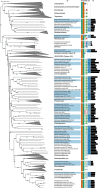
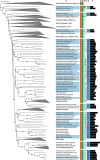

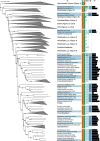
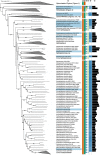
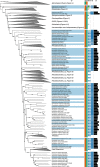


References
-
- Abdad M. Y., Abdallah R. A., El Karkouri K., Beye M., Stenos J., Owen H., et al. (2017). Rickettsia gravesii sp. nov.: a novel spotted fever group rickettsia in Western Australian Amblyomma triguttatum triguttatum ticks. Int. J. Syst. Evol. Microbiol. 67 3156–3161. 10.1099/ijsem.0.001865 - DOI - PubMed
-
- Abraham W. R., de Carvalho M. P., da Costa Neves T. S. P., Memoria M. T., Tartuci I. T., Vancanneyt M., et al. (2017). Proposal of Henriciella barbarensis sp. nov. and Henriciella algicola sp. nov., stalked species of the genus and emendation of the genus Henriciella. Int. J. Syst. Evol. Microbiol. 67 2804–2810. 10.1099/ijsem.0.002024 - DOI - PubMed
-
- Abraham W.-R., Lünsdorf H., Vancanneyt M., Smit J. (2013). Cauliform bacteria lacking phospholipids from an abyssal hydrothermal vent: proposal of Glycocaulis abyssi gen. nov., sp. nov., belonging to the family Hyphomonadaceae. Int. J. Syst. Evol. Microbiol. 63 2207–2215. 10.1099/ijs.0.047894-0 - DOI - PubMed
-
- Abraham W. R., Macedo A. J., Lünsdorf H., Fischer R., Pawelczyk S., Smit J., et al. (2008). Phylogeny by a polyphasic approach of the order Caulobacterales, proposal of Caulobacter mirabilis sp. nov., Phenylobacterium haematophilum sp. nov. and Phenylobacterium conjunctum sp. nov., and emendation of the genus Phenylobacterium. Int. J. Syst. Evol. Microbiol. 58(Pt 8) 1939–1949. 10.1099/ijs.0.65567-0 - DOI - PubMed
-
- Abraham W.-R., Strömpl C., Meyer H., Lindholst S., Moore E. R. B., Christ R., et al. (1999). Phylogeny and polyphasic taxonomy of Caulobacter species. Proposal of Maricaulis gen. nov. with Maricaulis maris (Poindexter) comb. nov. as the type species, and emended description of the genera Brevundimonas and Caulobacter. Int. J. Syst. Bacteriol. 49(Pt 3) 1053–1073. 10.1099/00207713-49-3-1053 - DOI - PubMed
LinkOut - more resources
Full Text Sources
Other Literature Sources
Molecular Biology Databases
Research Materials
Miscellaneous

